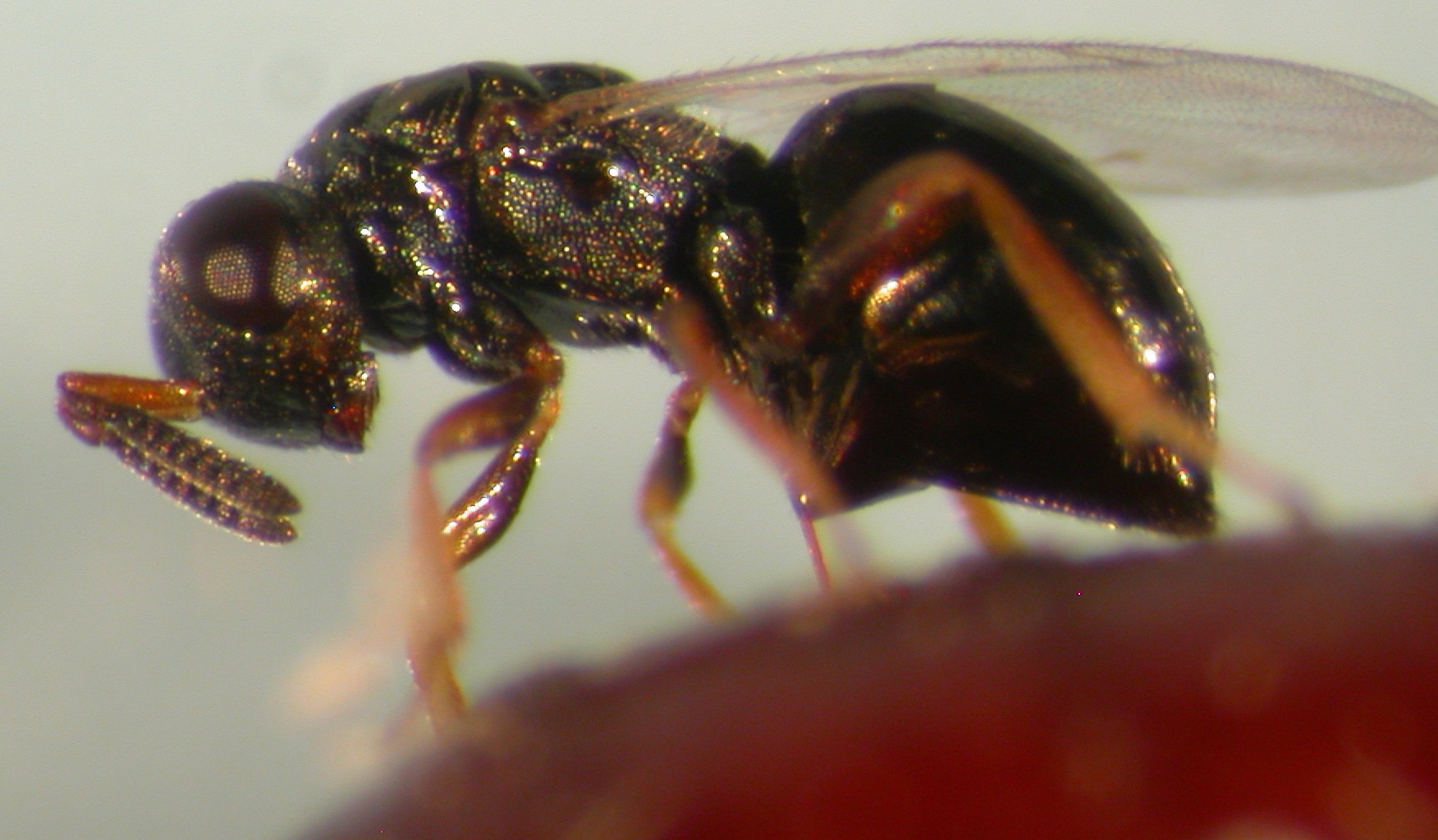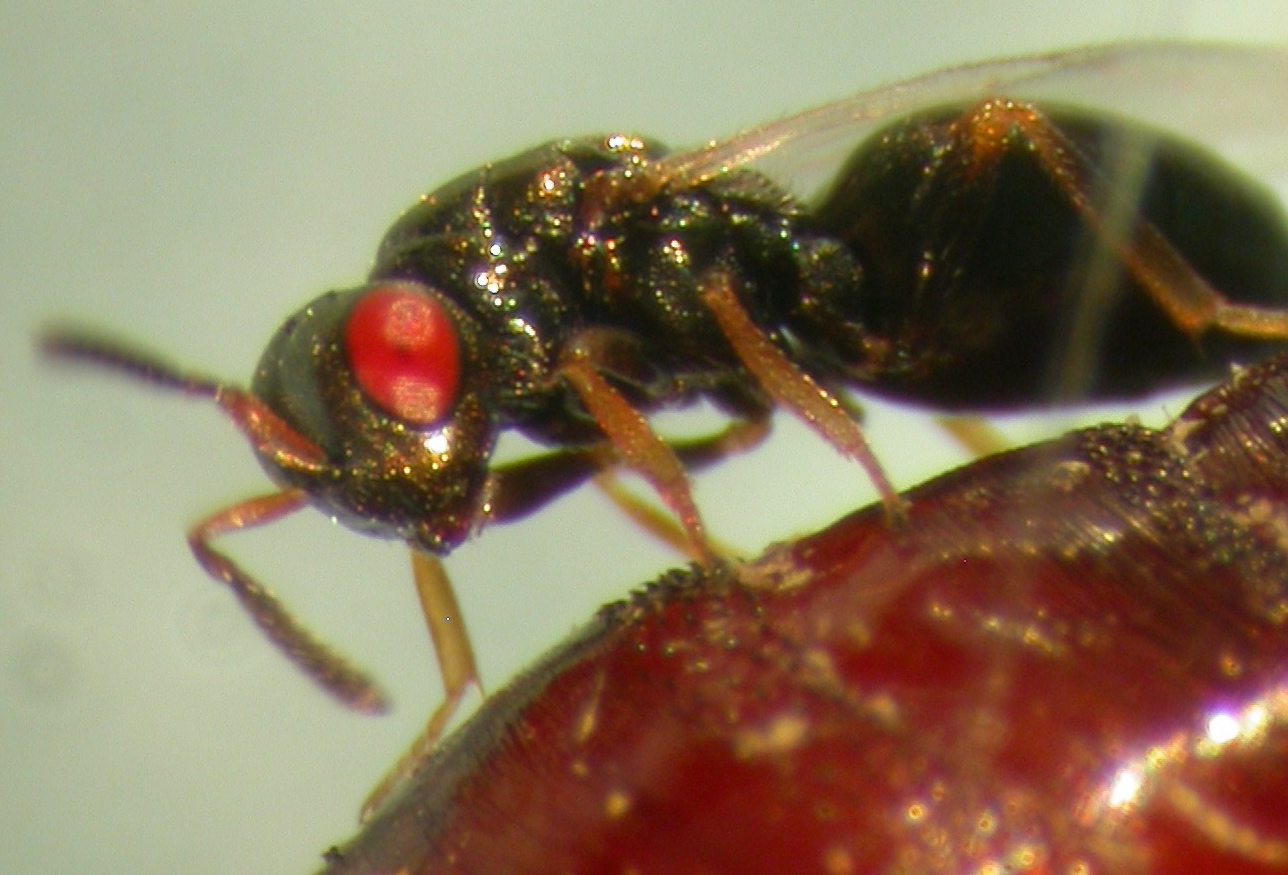Precision of sex ratio adjustment in the parasitoid wasp Nasonia vitripennis

 Hamilton's theory of local mate competition
(LMC) predicts female biased sex ratios when: (a) a small number of
females lay eggs per
patch, and (b) the resultant offspring mate amongst themselves before
only the females disperses. Some of the clearest support for
this prediction has come from the parasitoid wasp N. vitripennis. We are exploiting
this previous work to use sex ratio behaviour in this organism as a
model trait for examining the constraints that prevent 'perfect'
adaptation.
Hamilton's theory of local mate competition
(LMC) predicts female biased sex ratios when: (a) a small number of
females lay eggs per
patch, and (b) the resultant offspring mate amongst themselves before
only the females disperses. Some of the clearest support for
this prediction has come from the parasitoid wasp N. vitripennis. We are exploiting
this previous work to use sex ratio behaviour in this organism as a
model trait for examining the constraints that prevent 'perfect'
adaptation.
To date we have been focusing on three issues: (A) Mechanistic issues,
and especially how
individuals are constrained by their ability to process relevant
information about the environment. This has been facilitated by the
use of eye colour mutants (photo above right) to follow the behaviour
of individuals with relative ease. (B) What is happeing in field
populations? (C) The importance of genetic
architecture (mutation, pleiotropy etc) for
constraining sex ratio behaviour. Our main
findings include:
- The eggs laid by other females are a more
important cue for shifting sex ratios then the presence of other
females (Shuker & West, 2004 PNAS;
Shuker et al 2007 Anim. Behav.).
- Females adjust their offspring sex ratios more
precisely then previously realised, with adaptive sex ratio variation
within a patch, in response to variation in when different broods will
emerge (Shuker et al, 2005 Am. Nat.; Shuker et al. 2006 Behav.
Ecol.).
- Several potentially important factors have
negligible effects on offspring sex ratios. Specifically: (i) Females
do not adjust their offspring sex ratios as predicted in response to
relatedness to their mates or other females - conflict of interest
between individuals maybe a constraint preventing this (Reece et al.
2004 J Evo. Biol.; Shuker et
al. 2004 Evol. Ecol. Res.;
Shuker et al. 2004 Anim. Behav.).
(ii) Aysmetric
larval competition between male and female larvae is relatively weak
(Sykes
et al. 2007 Behav. Ecol. Sociobiol.) (iii) Males have either no
or
a small influence on offspring sex ratios (Shuker et al. 2006 Behav.
Ecol.).
- The findings of in our laboratory experiments are
supported by the data from natural field populations (Burton-Chellew et
al. 2009 Am. Nat.).
- The genetic variance for sex ratio behaviour in
natural populations is to low to be explained by mutation-selction
balance and the observed mutability of sex ratio behaviour (one
mutation every 5-60 generations that shifts the sex ratio by
approximately 0.01), suggesting that sex ratio mutations also have
deleterious effects on other traits (Pannebakker et al. 2008 Evolution).
We are also complementing this
research with: (A) our wider comparative
studies;
(B) experimental studies on the lack of sex ratio adjustment in Melittobia
parasitoids.
This work is led by Dave
Shuker, with Bart Pannebakker, Ed Sykes, Max Burton & Sarah Reece. It also
involves collaboration on theoretical modelling with Ido Pen (Groningen
University, Netherlands), and field and genetic work with Leo Beukeboom
(Groningen) and Juergen Gadeau (Wurzberg, Germany). Ali & Dan
developed the Nasonia games. We are
particularly interested in gaining students/fellows/collaborators with
different backgrounds
and skills to ours - we have a trait where we understand the fitness
consequences and behavioural cues very well, and have enormous
potential
to exploit this from all possible angles.
Related Publications
- Burton-Chellew, M.N., Koevoets, T., Grillenberger, B.K, Sykes,
E.M., Underwood, S.L., Bijlsma, K., Gadau, J., van de Zande, L.,
Beukeboom, L.W., West, S.A. & Shuker, D.M. (2008) Facultative sex ratio adjustment
in natural populations of wasps: cues of local mate competition and the
precision of adaptation. American
Naturalist 172, 393-404.
- Pannebakker, B.A., Halligan, D.L., Reynolds, K.T., Ballantyne,
G.A., Shuker, D.M., Barton, N. & West, S.A. (2008) Effects of
spontaneous mutation accumulation on sex ratio traits in a parasitoid.
Evolution 62, 1921-1935.
- Shuker, D.M., Reece, S.E., Lee, A. Graham, A., Duncan, A.B. &
West, S.A. (2007). Information
use in space and time: sex allocation behaviour in the parasitoid wasp Nasonia
vitripennis. Animal Behaviour, 73, 971-977.
- Sykes, E.M., Innocent, T.M., Pen, I., Shuker, D.M. & West,
S.A. (2007) Asymmetric larval
competition in the parasitoid wasp Nasonia vitripennis: a role in sex
allocation. Behavioral Ecology & Sociobiology, 61,
1751-1758.
- Shuker, D.M., Pen, I. & West, S.A (2006) Sex ratios under asymmetrical
local mate competition in the parasitoid wasp Nasonia vitripennis.
Behavioral Ecology 17, 345-352.
- Shuker, D.M., Sykes, E.M., Browning, L.E., Beukeboom, L.W. &
West, S.A. (2006) Male influence
on sex allocation in the parasitoid wasp Nasonia vitripennis.
Behavioral Ecology & Sociobiology 59, 829-835.
- Shuker, D.M., Pen, I., Duncan, A.B., Reece, S.E. & West, S.A.
(2005) Sex ratios under asymmetrical
local mate competition: theory and a test with parasitoid wasps. American
Naturalist 166, 301-316.
- Reece, S.E., Shuker, D.M., Pen, I. Duncan, A.B., Choudhary, A.,
Batchelor, C.M. & West, S.A. (2004) Kin
discrimination and sex ratios in
a parasitoid wasp. Journal of
Evolutionary
Biology , 17, 208-216.
- Shuker, D.M. & West, S.A. (2004) Information constraints and the
precision of adaptation. Proceedings of the National Academy of
Science, USA, 101, 10363-10367. {Current
Biology Commentary}
- Shuker, D.M., Reece, S.E., Whitehorn, P.R. & West, S.A.
(2004) Sib-mating does not lead
to facultative sex ratio adjustment in the parasitoid wasp, Nasonia
vitripennis. Evolutionary Ecology Research, 6, 473-480.
- Shuker, D.M., Reece, S.E., Taylor, J. & West, S.A. (2004) Wasp sex ratios when females on
a patch can be related. Animal Behaviour, 68, 331-336.
- Flanagan, K.E., West, S.A. & Godfray, H.C.J. (1998) Local mate competition, variable
fecundity, and information use in a parasitoid. Animal Behaviour,
56, 191-198.
BACK TO SEX
ALLOCATION PAGE BACK
TO WEST GROUP HOME PAGE